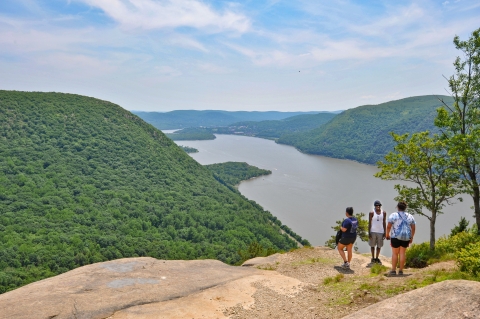Have you ever wanted to enjoy an outdoor experience not far from New York City? You may not have imagined that natural landscapes exist within reach of the city’s edge. But within the Highlands region of New York — only a train or car ride away — there are opportunities as far as the eye can see to explore and experience the wonders of nature.
“This is land for the people who live locally or from anywhere around the globe. It is wonderful to have people come here from all over the world and say, ‘I can’t believe I can get on a train from New York City and hike for two or three hours,’” said Evan Thompson, manager of Clarence Fahnestock Memorial State Park, Hudson Highlands State Park and Wonder Lake State Park.
These parks are in the heart of the Highlands region, a 3.4-million-acre landscape of Appalachian ridges, hills and plateaus that extends from northwestern Connecticut, through New York and New Jersey, into eastern Pennsylvania. Since 2004, funds available through the Highlands Conservation Act grant program have helped the parks expand. With each property purchased, more habitat is conserved and miles of trails extended, providing more space for visitors to recreate and enjoy the beauty of the area.
“This land is not just for us to hold; it’s for people to enjoy. Having so many types of properties allows for people of all ages and ability levels to come here and have outdoor experiences,” said Thompson, who noted that they are nearing their goal of connecting Clarence Fahnestock with Hudson Highlands State Park. “There are over one hundred miles of trails between the two parks. Trails that are flat, trails that are steep. This gives everyone an opportunity to experience it, no matter their level of physical fitness.”
Highlands Conservation Act land-acquisition grants are administered by the Service’s Wildlife and Sport Fish Restoration program, which awards funding for land-conservation projects to state agencies. With an update to the Highlands Act in 2022, counties and municipalities are also eligible to receive grants. To date, this unique public-and-private partnership has conserved more than 15,000 acres.
Highlands Act funds have added nearly 3,000 acres to Clarence Fahnestock and Hudson Highlands state parks, increasing recreation opportunities. Expansion of Clarence Fahnestock will link the park to key agritourism opportunities in the area, including apple-picking. In the winter, cross-country skiing can be enjoyed on many of the hiking trails, and a winter park offers groomed trails and sledding. Horseback riding and mountain biking are permitted in certain areas.
The diversity of habitats in the parks allows for abundant wildlife, including bald eagles, peregrine falcons, wood turtles, box turtles, New England cottontails and eastern fence lizards. Prickly pear cactus grows in areas with dry, sandy soil.
“Conserving natural areas at state parks in the Highlands Region benefits local residents and visitors alike,” said Colleen Scully, assistant regional director for the Service’s Wildlife and Sport Fish Program in the Northeast. “Beyond recreation, these areas safeguard drinking water resources that serve millions of people, protect important wildlife habitat and help build a landscape more resilient to the effects of climate change climate change
Climate change includes both global warming driven by human-induced emissions of greenhouse gases and the resulting large-scale shifts in weather patterns. Though there have been previous periods of climatic change, since the mid-20th century humans have had an unprecedented impact on Earth's climate system and caused change on a global scale.
Learn more about climate change .”
Linda Cooper, Taconic Region director for the New York State Office of Parks, Recreation and Historic Preservation, is grateful for the parks’ expansion.
“We are blessed with incredible habitat in this area. There are so many species as well as great beauty; it is outstanding to be able to preserve it,” said Cooper.
She’s motivated to continue the work.
“The ability to get Highlands Conservation Act grant funding to offset local dollars has been significant. It allows us to think big. It allows us to look at the landscape and preserve it for generations to come, and not just preserve it, but make it available to the public,” said Cooper.
Highlands Act funds have allowed the parks to grow large enough to conserve species, Cooper said. Future plans include encouraging visitors to interact with the landscape, learning to respect and steward it.
“What you learn during your park visit we hope you carry through every aspect of your life, wherever you’re from,” she said.
Making the parks available to more people, in addition to protecting their natural beauty, is a priority. Connecting the parks will allow for longer trails and a more diverse hiking experience. A new, accessible trail, the Hudson Highlands Fjord Trail, will allow people to enjoy the landscape whether going for a casual stroll, pushing a baby stroller or having limited mobility that makes steeper terrain difficult. Furthermore, adding parcels along the Appalachian Trail will protect the iconic path's scenic beauty.
“People are looking to create memories, looking for those moments that make them feel at peace, at home,” said Cooper. “In this area, we can build beautiful trails that bring people together to enjoy the outdoors. Bringing your family to the parks, going on walks together, experiencing nature at a young age, it is formative for people to have those experiences. It’s part of what makes you feel human and a part of the earth.”
All a stone’s throw from the Big Apple ...






